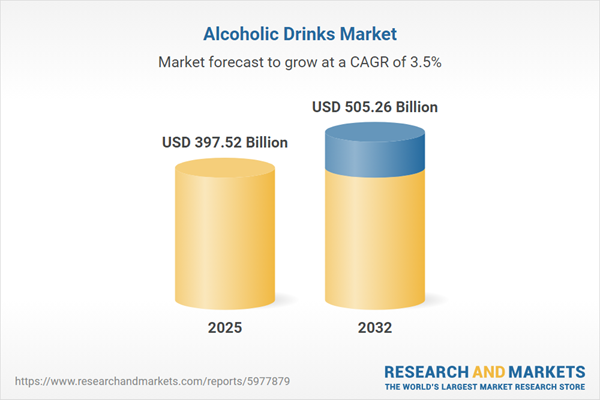Speak directly to the analyst to clarify any post sales queries you may have.
The alcoholic drinks market is experiencing significant transformation, driven by shifting consumer expectations, digital disruption, and evolving global regulations. Businesses navigating this space must adapt strategically, balancing traditional values with innovative approaches to successfully capture emerging opportunities.
Market Snapshot: Alcoholic Drinks Market Growth and Outlook
The Alcoholic Drinks Market grew from USD 384.24 billion in 2024 to USD 397.52 billion in 2025. It is expected to continue growing at a CAGR of 3.48%, reaching USD 505.26 billion by 2032. This growth reflects global trends toward premiumization, health-conscious choices, and a strong push for sustainability and digital commerce within the alcoholic beverage industry.
Scope & Segmentation
This report offers in-depth qualitative and quantitative analysis, detailing the evolving landscape across product categories, supply chains, and consumer touchpoints. The comprehensive segmentation supports executives in identifying actionable areas for investment, strategy, and innovation.
- Product Types: Focus areas include beer, cider, spirits, and wine, covering subcategories such as brown ale, pilsner, stout, dry and sweet cider, brandy (with armagnac and cognac), gin, rum, tequila, vodka, whiskey (bourbon, Irish, Scotch), fortified, red, rosé, sparkling, and white wines.
- Distribution Channels: Analysis spans convenience stores, hypermarkets/supermarkets, online retail (brick and click, pure e-retailers), specialty stores, bars, pubs, hotels, nightclubs, and restaurants.
- Packaging Types: Breakdown includes glass and plastic bottles, cans, kegs, and innovative formats like Tetra Pak brick packs and pouches.
- Price Tiers: Coverage of economy, standard, and premium options to reflect different value propositions and purchasing behaviors.
- Alcohol Content Levels: Overview spans high, low, non-alcoholic, and regular alcoholic products to map shifting lifestyle preferences.
- Regional Coverage: Geographic markets analyzed include North and Latin America, Europe (including Western, Eastern, and Northern), Middle East, Africa, and Asia Pacific, highlighting distinct regulatory, cultural, and economic environments.
- Leading Companies: The research features key strategies and recent analysis for major brands including Anheuser-Busch InBev, Diageo, Heineken, Pernod Ricard, Carlsberg, Constellation Brands, Asahi Group Holdings, Molson Coors, Kirin Holdings, and Brown-Forman.
Key Takeaways for Strategic Decision-Makers
- Consumer demand is shifting toward premium, craft, and health-oriented alcoholic beverage products, motivating brands to diversify portfolios and reinforce value propositions.
- Digital transformation, including e-commerce expansion and direct-to-consumer outreach, is redefining distribution strategies and enhancing brand engagement.
- Sustainability is a growing competitive differentiator, compelling companies to invest in eco-friendly packaging, renewable energy use, and transparent supply chains.
- Regional consumer behaviors differ markedly, requiring tailored product development, channel investment, and pricing approaches tuned to local traditions and market maturity.
- Segmentation by beverage type and alcohol content allows for more precise targeting, while data-driven personalization supports deeper consumer loyalty across multiple touchpoints.
- Strategic alliances with local players and cross-industry collaborations drive innovation, enabling brands to respond to evolving regulatory and consumer demands.
Tariff Impact: U.S. Policy Developments and Global Market Response
The 2025 introduction of new tariffs in the United States has catalyzed changes for importers, distributors, and producers. These policy shifts necessitate reevaluation of sourcing, logistics, and pricing, spurring diversification into new supplier geographies and an increased focus on domestic capabilities. Brands seeking to remain competitive are adjusting product offerings and operational models to manage incremental costs and supply chain friction, while retailers leverage efficiency initiatives to absorb or pass on impacts to consumers.
Methodology & Data Sources
This report applies a rigorous multi-phase research methodology, including interviews with industry executives, consumer surveys, and analysis of trade data, regulatory filings, and financial disclosures. Data triangulation and benchmarking techniques ensure accuracy, with insights validated by sector specialists and continuous quality controls throughout the research process.
Why This Report Matters
- Enables senior leaders to anticipate disruptive trends, manage regulatory risk, and align investments with the market’s most dynamic growth segments.
- Provides granular competitive intelligence, empowering more effective resource allocation and go-to-market strategies tailored to regional and segment-specific opportunities.
- Equips decision-makers to adapt quickly, supporting resilience and innovation in a complex and rapidly evolving business climate.
Conclusion
The alcoholic drinks market is emerging as a dynamic arena for innovation and strategic repositioning. With actionable insights and clear segmentation, this report empowers organizations to respond confidently to market challenges and opportunities, supporting sustainable leadership and long-term value creation.
Additional Product Information:
- Purchase of this report includes 1 year online access with quarterly updates.
- This report can be updated on request. Please contact our Customer Experience team using the Ask a Question widget on our website.
Table of Contents
3. Executive Summary
4. Market Overview
7. Cumulative Impact of Artificial Intelligence 2025
Companies Mentioned
The companies profiled in this Alcoholic Drinks market report include:- Anheuser-Busch InBev SA/NV
- Diageo plc
- Heineken N.V.
- Pernod Ricard SA
- Carlsberg A/S
- Constellation Brands, Inc.
- Asahi Group Holdings, Ltd.
- Molson Coors Beverage Company
- Kirin Holdings Company, Limited
- Brown-Forman Corporation
Table Information
| Report Attribute | Details |
|---|---|
| No. of Pages | 194 |
| Published | November 2025 |
| Forecast Period | 2025 - 2032 |
| Estimated Market Value ( USD | $ 397.52 Billion |
| Forecasted Market Value ( USD | $ 505.26 Billion |
| Compound Annual Growth Rate | 3.4% |
| Regions Covered | Global |
| No. of Companies Mentioned | 11 |









